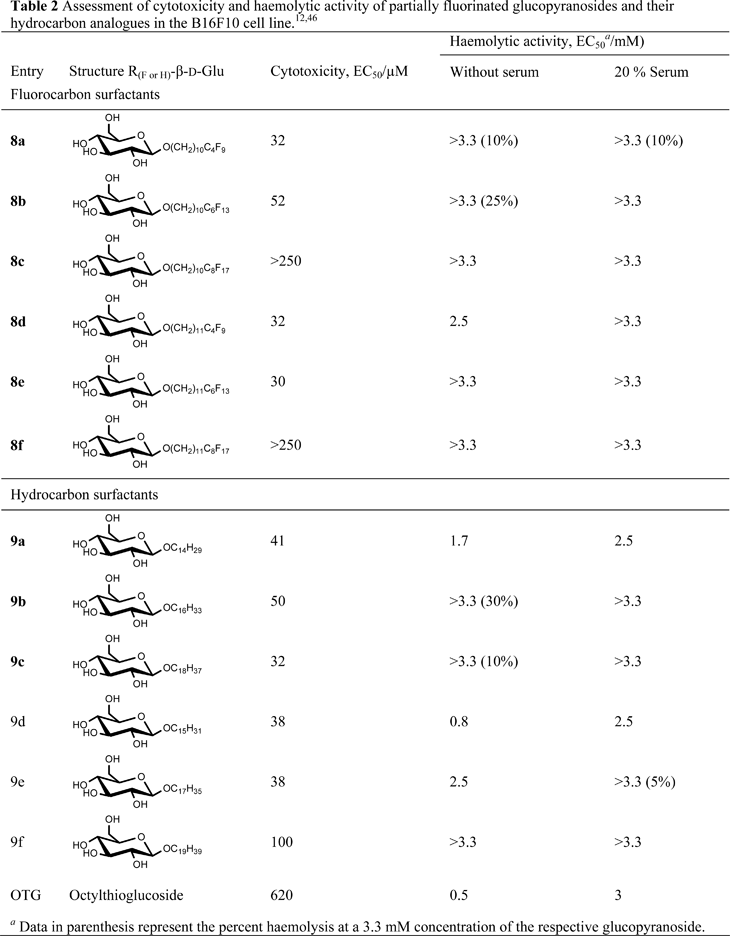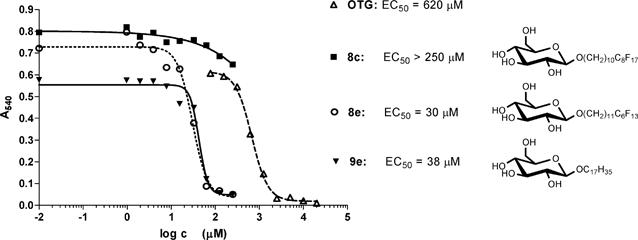
Addition and correction
Synthesis and biocompatibility evaluation of fluorinated, single-tailed glucopyranoside surfactants
Xueshu Li, Jaroslav Turánek, Pavlína Knötigová, Hana Kudláčková, Josef Maŝek, D. Brant Pennington, Stephen E. Rankin, Barbara L. Knutson and Hans‑Joachim Lehmler
New J. Chem., 2008, 32, 2169 (DOI: b805015e). Amendment published 16th January 2009.
The EC50 values for the cytotoxicity and the haemolytic activity of the glucopyranoside surfactants were calculated with an incorrect dilution factor and are lower compared to the data presented in the manuscript.
The first three sentences in the second paragraph under Biological studies should read:
The partially fluorinated glucopyranosides 8a–b and 8d–e were moderately toxic, with EC50 values ranging from 30 to 52 μM. These EC50 values are comparable to the EC50 values of the analogous hydrocarbon derivatives 9a–d, which ranged from 38 to 50 μM. This is in contrast to the positive control, octylthioglucoside (OTG), which did not show significant cytotoxicity over the same concentration range.
The first sentence of the third paragraph under Biological studies should read:
The two glucopyranosides 8c and 8f with the perfluorooctyl terminus were even less toxic than 8a–b and 8d–e, with EC50 values >250 μM.
The beginning of the fourth paragraph under Biological studies should read:
The results from the MTT assay were further confirmed by Hoffman modulation contrast microscopy (Fig. 3). In agreement with the results form the MTT assay, treatment of B16F10 cells with high concentrations of surfactant 8c (24 h, 250 μM) surfactant neither altered cell growth nor induced morphological changes in comparison to the control (Fig. 3(A) and (B)). In contrast, surfactants 8e and 9e induced retardation in cell proliferation and caused an abnormal prolongated morphology of the cells at a concentration close to the EC50 (Fig. 3(C) and (D)). In addition, both surfactants induced apoptosis in a significant number of cells. No viable cells were observed at high concentrations (250 μM) of 8e and 9e (Fig. 3(E) and (F)).
The beginning of the last paragraph under Biological studies should read:
In addition to the cytotoxicity experiments, the haemolytic activity of all surfactants was assessed using rabbit red blood cells. The glucopyranosides 8a–f and 9a–f were haemolytic at low millimolar concentrations. The haemolytic activity decreased for both groups of surfactants in the presence of serum, with EC50 values > 2.5 mM in the presence of serum and >0.8 mM in the absence of serum.
The caption to Fig. 3 should read:
Fig. 3 Cytotoxic effect of glucopyranosides 8c, 8e and 9e in the B16F10 mouse melanoma cell line. The B16F10 cells were treated for 24 h with (A) the vehicle (PBS + 1% DMSO) or with glucopyranoside (B) 8c (250 μM), (C) 8e (41 μM, black arrows indicate abnormal spindle-shaped cells), (D) 9e (41 μM, black arrow indicate abnormal spindle-shaped cell, white arrow indicate typical necrotic cell), (E) 8e (250 μM) or (F) 9e (250 μM, black arrows indicate cellular debris, white arrows indicate necrotic cells). The fluorescent markers Yo-Pro-1 (green) and PI (red/yellow) were used for the visualization of early apoptotic changes and post-apoptotic secondary necrosis in B16F10 cells treated for 24 h with (G) vehicle (green arrows indicate early stage of apoptosis, orange arrows indicate late stage of apoptosis) or (H) 8e (41 μM, green arrows indicate early stage of apoptosis, orange arrows indicate late stage of apoptosis, red arrows indicate secondary necrosis). The cells were observed under an epifluorescent microscope.
The sentence describing the concentration range employed in the MTT-based cytotoxicity tests should read:
Glucopyranosides dissolved in sterile PBS (total volume of 20 mL) were added to each well and the cytotoxic effect was evaluated after 24 h of exposure over a concentration range from 1 to 250 μM using the MTT assay.
The sentence describing the concentration range employed for the determination of the haemolytic activity should read:
The surfactants were tested in concentration range extending from 6.6 μM to 3.3 mM.
The EC50 values in Table 2 should read as follows:

The cytotoxicity curves for surfactants 8c, 8e and 9e and octylthioglucoside (OTG) in Fig. 2 have been corrected. Fig. 2 should look as follows:

Fig. 2 Cytotoxic effect of glucopyranosides 8c, 8e and 9e in the B16F10 mouse melanoma cell line. B16F10 cells were exposed for 24 h to the respective glucopyranoside at the concentrations shown and assessed for MTT activity as described in the Experimental section. A representative hydrocarbon surfactant, octylthioglucoside (OTG), is shown for comparison.
The Royal Society of Chemistry apologises for these errors and any subsequent inconvenience to authors and readers.